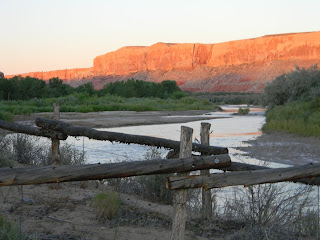Cataract Canyon on the Colorado River is one of those whitewater
experiences that can be extremely different from year to year depending on the
water level. Changes in the character of a rapid is one of the things that
draws us back to the same river many times over.
Cataract Canyon has some of the most extreme differences in volume
of all the western big water rivers because the dams that regulate the flow
come from both the Green River and the Colorado River many miles upstream
before they reach the confluence of the Green and Colorado, just a few miles
above the start of Cataract Canyon. This combination of two large rivers often
means a lot of water during the spring runoff.
For those of us who prefer an oar-powered experience instead
of using an outboard motor, a high water run through Cataract Canyon (Cat for
short) borders on insanity!
Oar-powered automatically means much smaller rafts compared
to most motor rigs.
Add to that some “old school” equipment like bucket boats
instead of self-bailers, and the running the ‘big stuff’ in high water is best
described as an almost “out of control” experience.
The reason it becomes extremely difficult is a bucket boat
will fill with water in the first wave in a big rapid and then the raft is just
too heavy to maneuver by one person at the oars. In a bucket boat, the
passengers man 5 gallon buckets to scoop out the water, usually after running
the rapid is done.
This becomes an exceptional challenge in Cat because the most
challenging rapids, Big Drop One, Two, and Three come in quick succession without
much time to bail out a bucket boat before the next Big Drop.
A raft that is too heavy with water to maneuver is most likely
going to be drawn into a massive hole in Big Drop Three, affectionately called
Satan’s Gut, where the likelihood of a flip is almost guaranteed in a high
water run.
In contrast, in a low water run when scouting Big Drop Three
it becomes very easy to see what creates Satan’s Gut. There is a huge rock that
becomes exposed in low water called Big Mossy.
At medium river flows Big Mossy is just a section of the rapid
to be avoided by a nice route just right of center at the top of the rapid.
In low water, the right of center route is too rocky to make
right of center an option and the only viable route is a small gap in the rocky
sections that cover most of the river and to get uncomfortably close to Big
Mossy as it looms large out of the water.
As I studied Big Drop Three to figure out a low water route
it occurred to me that Big Mossy has been around for a long, long time. And
that it will be there for a long time after I make my exit from Planet Earth.
My next thought was even though Big Mossy will be around for
a long time, the river will win this battle of resistance, and Big Mossy will eventually
disappear. Even though Big Mossy will continue to block the river and appear to
be unmoved and winning this war of resistance to the river for a long time.
But the river is persistent. And that continued persistence
will wear down Big Mossy, slowly from our point of view, but every minute the
process of wearing down Big Mossy continues.
Frequently when we set really challenging and optimistic
goals, we only recognize the resistance to the process and wonder if we will
ever succeed with big goals.
In some cases, we may discover the time needed to accomplish
the large ambitious goal is a price we are no longer willing to pay. That’s not
the same as giving up because it’s hard and we are just not exercising enough
persistence.
I like Seth Godin’s perspective that sometimes we find we
are proverbially in a cul-de-sac and there isn’t any way through to completion.
Compared to a dip in the road that just requires more effort on the uphill side
of the dip.
When we find ourselves in the “dip” we simply need to recognize
more time and effort is needed to maintain our progress and break down the goal
into smaller incremental steps to be able to see, like the river, we just need
to persist for the amount of time required to achieve the big goal.
Most of life’s best rewards come from slowly and
systematically (think persistence) making small amounts of progress towards the
completion of our goals. We just don’t get to dynamite every big obstacle in
our “river of life” as a quick fix.
Bonus Idea: Who we become in the process of achieving
challenging goals is often of more value and longer lasting than the actual completion
and reward received from the goal.
For more information on personalized mentoring and coaching
programs, send me an email to chris@dtesuccess.com.
I coach the person who wants time and financial freedom, and to live a life of
purpose and meaning.
I guide you through a process where you develop a customized
plan to become the very best version of yourself. A plan to help you stop
wasting precious time and remove the uncertainty in your life. And replace it
with clarity and vision.
Email chris@dtesuccess.com
to schedule your free coaching session to create clarity and vision now!



















